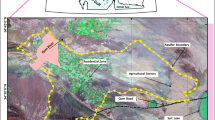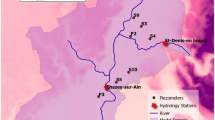Abstract
The need for freshwater is emerging as the utmost critical resource issue facing humanity. In several arid and semi-arid parts of the world, groundwater resources are being used as an alternative source of freshwater. Excessive and/or unplanned groundwater withdrawals have a negative impact on the aquifer. Groundwater withdrawn from coastal aquifers are susceptible to contamination by saltwater intrusion. This study investigates the efficiency and viability of using artificial freshwater recharge (AFR) to increase fresh groundwater pumping from production wells for beneficial use. A three dimensional (3D), transient, density dependent, finite element based flow and transport model of an illustrative coastal aquifer is implemented using FEMWATER code. First, the effect of AFR on inland encroachment of saline water is quantified for existing scenarios. Specifically, groundwater head and salinity concentration differences at monitoring locations before and after artificial recharge is presented. Second, a multi-objective management model incorporating groundwater pumping and AFR is implemented to control groundwater salinization in an illustrative coastal aquifer system. To avoid computational burden and ensure computational feasibility, the numerical flow and transport simulation model is substituted by the new support vector regression (SVR) predictive models as approximate simulators in the simulation–optimization framework for developing optimal management strategies. The performance evaluation results indicated that the SVR models were adequately trained and were capable of approximating saltwater intrusion processes in the aquifer. Multi-objective genetic algorithm (MOGA) is used to solve the multi-objective optimization problem. The Pareto-optimal front obtained as solution from the SVR–MOGA optimization model presented a set of optimal solutions needed for the sustainable management of the coastal aquifer. The pumping strategies obtained as Pareto optimal solutions with and without freshwater recharge wells showed that saltwater intrusion is sensitive to the AFR. Also, the hydraulic head lenses created by AFR can be used as one practical option to control saltwater intrusion in coastal aquifers. The developed 3D saltwater intrusion model, predictive capability of the developed SVR models and the feasibility of using the proposed linked multi-objective SVR–MOGA optimization model makes the proposed methodology potentially attractive in solving large scale regional saltwater intrusion management problems.













Similar content being viewed by others
References
Abd-Elhamid HF, Javadi AA (2011) A cost-effective method to control seawater intrusion in coastal aquifers. Water Res Manag 25:2755–2780
Ahmed AT (2017) Experimental and numerical study for seawater intrusion remediation in heterogeneous coastal aquifer. J Environ Manag 198:221–232
Ashrafzadeh A, Roshandel F, Khaledian M, Vazifedoust M, Rezaei M (2016) Assessment of groundwater salinity risk using kriging methods: a case study in northern Iran. Agric Water Manag 178:215–224
Ataie-Ashtiani B, Ketabchi H (2011) Elitist continuous ant colony optimization algorithm for optimal management of coastal aquifers. Water Res Manag 25:165–190
Ataie-Ashtiani B, Ketabchi H, Rajabi MM (2013) Optimal management of a freshwater lens in a small island using surrogate models and evolutionary algorithms. J Hydrol Eng 19:339–354
Badiuzzaman P, McLaughlin E, McCauley D (2017) Substituting freshwater: can ocean desalination and water recycling capacities substitute for groundwater depletion in California? J Environ Manag 203:123–135
Bajer L, Holena M (2012) RBF-based surrogate model for evolutionary optimization. In: ITAT. Citeseer, pp 3–8
Basak D, Pal S, Patranabis DC (2007) Support vector regression. Neural Inf Process 11:203–224
Bechikh S, Said LB, Ghédira K (2011) Searching for knee regions of the Pareto front using mobile reference points. Soft Comput 15:1807–1823
Benseddik B, El Mrabet E, El Mansouri B, Chao J, Kili M (2017) Delineation of artificial recharge zones in Mnasra Aquifer (NW, Morocco). Model Earth Syst Environ 3:10
Bhattacharjya RK, Datta B (2009) ANN-GA-based model for multiple objective management of coastal aquifers. J Water Res Plan Manag 135:314–322
Chevalier RF, Hoogenboom G, McClendon RW, Paz JA (2011) Support vector regression with reduced training sets for air temperature prediction: a comparison with artificial neural networks. Neural Comput Appl 20:151–159
Chitralekha SB, Shah SL (2010) Application of support vector regression for developing soft sensors for nonlinear processes. Can J Chem Eng 88:696–709
Clark R, Gonzalez D, Dillon P, Charles S, Cresswell D, Naumann B (2015) Reliability of water supply from stormwater harvesting and managed aquifer recharge with a brackish aquifer in an urbanising catchment and changing climate. Environ Model Softw 72:117–125
Das A, Datta B (1999) Development of multiobjective management models for coastal aquifers. J Water Res Plan Manag 125:76–87
Datta B, Peralta RC (1986) Interactive computer graphics-based multiobjective decision-making for regional groundwater management. Agric Water Manag 11:91–116
Dey NC, Saha R, Parvez M, Bala SK, Islam AS, Paul JK, Hossain M (2017) Sustainability of groundwater use for irrigation of dry-season crops in northwest Bangladesh. Groundw Sustain Dev 4:66–77
Dhar A, Datta B (2009) Saltwater intrusion management of coastal aquifers. I: linked simulation-optimization. J Hydrol Eng 14:1263–1272
Dokou Z, Dettoraki M, Karatzas GP, Varouchakis EA, Pappa A (2017) Utilizing successive linearization optimization to control the saltwater intrusion phenomenon in unconfined coastal aquifers in Crete, Greece. Environ Model Assess 22:115–128
Don NC, Hang NTM, Araki H, Yamanishi H, Koga K (2006) Groundwater resources and management for paddy field irrigation and associated environmental problems in an alluvial coastal lowland plain. Agric Water Manag 84:295–304
Essink GHO (2001) Improving fresh groundwater supply—problems and solutions. Ocean Coast Manag 44:429–449
Gano S, Kim H, Brown D (2006) Comparison of three surrogate modeling techniques: datascape, kriging, and second order regression. In: 11th AIAA/ISSMO Multidisciplinary Analysis and Optimization Conference, p 7048
Gong M, Li H, Jiang X (2016) A multi-objective optimization framework for ill-posed inverse problems. CAAI Trans Intell Technol 1:225–240
Gretton A, Doucet A, Herbrich R, Rayner PJ, Scholkopf B (2001) Support vector regression for black-box system identification. In: Proceedings of the 11th IEEE Workshop on Statistical Signal Processing. IEEE, pp 341–344
Guttman J, Negev I, Rubin G (2017) Design and testing of recharge wells in a coastal aquifer: summary of field scale pilot tests. Water 9:53
Hashemi H, Berndtsson R, Kompani-Zare M, Persson M (2013) Natural vs. artificial groundwater recharge, quantification through inverse modeling. Hydrol Earth Syst Sci 17:637–650
He Z, Wen X, Liu H, Du J (2014) A comparative study of artificial neural network, adaptive neuro fuzzy inference system and support vector machine for forecasting river flow in the semiarid mountain region. J Hydrol 509:379–386
Hussain MS, Javadi AA, Ahangar-Asr A, Farmani R (2015) A surrogate model for simulation–optimization of aquifer systems subjected to seawater intrusion. J Hydrol 523:542–554
Hussain M, Javadi A, Sherif M (2016) Artificial recharge of coastal aquifers using treated wastewater to control saltwater intrusion. In: 24th UK Conference of the Association for Computational Mechanics in Engineering, Cardiff 2016. p 4. https://doi.org/10.13140/RG.2.1.2285.9920
Islam M, Hoque MM (2016) Multiwell technique of saline and nonsaline groundwater pumping from coastal aquifers. Environ Qual Manag 25:35–47
Javadi A, Hussain M, Sherif M, Farmani R (2015) Multi-objective optimization of different management scenarios to control seawater intrusion in coastal aquifers. Water Resour Manag 29:1843–1857
Juang CH, Wang L, Hsieh H-S, Atamturktur S (2014) Robust geotechnical design of braced excavations in clays. Struct Saf 49:37–44
Kourakos G, Mantoglou A (2009) Pumping optimization of coastal aquifers based on evolutionary algorithms and surrogate modular neural network models. Adv Water Res 32:507–521
Kourakos G, Mantoglou A (2013) Development of a multi-objective optimization algorithm using surrogate models for coastal aquifer management. J Hydrol 479:13–23
Koussis A et al (2010) Cost-efficient management of coastal aquifers via recharge with treated wastewater and desalination of brackish groundwater: general framework. Hydrol Sci J 55:1217–1233
Lin H-CJ, Richards DR, Yeh G-T, Cheng J-R, Cheng H-P (1997) FEMWATER: a three-dimensional finite element computer model for simulating density-dependent flow and transport in variably saturated media. DTIC Document, Vicksburg
Lin RS, Horn SD, Hurdle JF, Goldfarb-Rumyantzev AS (2008) Single and multiple time-point prediction models in kidney transplant outcomes. J Biomed Inform 41:944–952
Loh W-L (1996) On Latin hypercube sampling. Ann Stat 24:2058–2080
Luyun R, Momii K, Nakagawa K (2011) Effects of recharge wells and flow barriers on seawater intrusion. Groundwater 49:239–249
Mahlknecht J, Merchán D, Rosner M, Meixner A, Ledesma-Ruiz R (2017) Assessing seawater intrusion in an arid coastal aquifer under high anthropogenic influence using major constituents, Sr and B isotopes in groundwater. Sci Total Environ 587:282–295
Mantoglou A (2003) Pumping management of coastal aquifers using analytical models of saltwater intrusion. Water Resour Res 39:1335
Owusu S, Mul ML, Ghansah B, Osei-Owusu PK, Awotwe-Pratt V, Kadyampakeni D (2017) Assessing land suitability for aquifer storage and recharge in northern Ghana using remote sensing and GIS multi-criteria decision analysis technique. Model Earth Syst Environ. https://doi.org/10.1007/s40808-017-0360-6
Papadopoulou MP, Nikolos IK, Karatzas GP (2010) Computational benefits using artificial intelligent methodologies for the solution of an environmental design problem: saltwater intrusion. Water Sci Technol 62:1479–1490
Park C-H, Aral MM (2004) Multi-objective optimization of pumping rates and well placement in coastal aquifers. J Hydrol 290:80–99
Park CH, Joo JG, Kim JH (2012) Integrated washland optimization model for flood mitigation using multi-objective genetic algorithm. J Hydro-environ Res 6:119–126
Peralta RC, Forghani A, Fayad H (2014) Multiobjective genetic algorithm conjunctive use optimization for production, cost, and energy with dynamic return flow. J Hydrol 511:776–785
Pool M, Carrera J (2010) Dynamics of negative hydraulic barriers to prevent seawater intrusion. Hydrogeol J 18:95–105
Ros SEM, Zuurbier KG (2017) The Impact of Integrated Aquifer Storage and Recovery and Brackish Water Reverse Osmosis (ASRRO) on a Coastal Groundwater System. Water 9:273
Roumasset JA, Wada CA (2010) Optimal and sustainable groundwater extraction. Sustainability 2:2676–2685
Roy DK, Datta B (2017a) Genetic algorithm tuned fuzzy inference system to evolve optimal groundwater extraction strategies to control saltwater intrusion in multi-layered coastal aquifers under parameter uncertainty. Model Earth Syst Environ. https://doi.org/10.1007/s40808-017-0398-5
Roy DK, Datta B (2017b) Saltwater intrusion processes in coastal aquifers—modelling and management: a review. Desalin Water Treat 78:57–89
Shu C, Ouarda T (2008) Regional flood frequency analysis at ungauged sites using the adaptive neuro-fuzzy inference system. J Hydrol 349:31–43
Sreekanth J, Datta B (2010) Multi-objective management of saltwater intrusion in coastal aquifers using genetic programming and modular neural network based surrogate models. J Hydrol 393:245–256
Sreekanth J, Datta B (2011) Coupled simulation-optimization model for coastal aquifer management using genetic programming-based ensemble surrogate models and multiple-realization optimization. Water Resour Res. https://doi.org/10.1029/2010WR009683
Tu JV (1996) Advantages and disadvantages of using artificial neural networks versus logistic regression for predicting medical outcomes. J Clin Epidemiol 49:1225–1231
Wen Y, Cai C, Liu X, Pei J, Zhu X, Xiao T (2009) Corrosion rate prediction of 3C steel under different seawater environment by using support vector regression. Corros Sci 51:349–355
Wu C-H, Ho J-M, Lee D-T (2004) Travel-time prediction with support vector regression. IEEE Trans Intell Transp Syst 5:276–281
Yang H, Chan L, King I (2002) Support vector machine regression for volatile stock market prediction. In: International Conference on Intelligent Data Engineering and Automated Learning. Springer, pp 391–396
Yoon H, Jun S-C, Hyun Y, Bae G-O, Lee K-K (2011) A comparative study of artificial neural networks and support vector machines for predicting groundwater levels in a coastal aquifer. J Hydrol 396:128–138
Yu P-S, Chen S-T, Chang I-F (2006) Support vector regression for real-time flood stage forecasting. J Hydrol 328:704–716
Zhang G, Ge H (2012) Prediction of xylanase optimal temperature by support vector regression. Electron J Biotechnol 15:7–7
Zhong Z-D, Zhu X-J, Cao G-Y (2006) Modeling a PEMFC by a support vector machine. J Power Sources 160:293–298
Author information
Authors and Affiliations
Corresponding author
Rights and permissions
About this article
Cite this article
Lal, A., Datta, B. Modelling saltwater intrusion processes and development of a multi-objective strategy for management of coastal aquifers utilizing planned artificial freshwater recharge. Model. Earth Syst. Environ. 4, 111–126 (2018). https://doi.org/10.1007/s40808-017-0405-x
Received:
Accepted:
Published:
Issue Date:
DOI: https://doi.org/10.1007/s40808-017-0405-x




